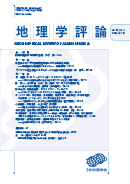Volume 97, Issue 1
Displaying 1-15 of 15 articles from this issue
- |<
- <
- 1
- >
- >|
REVIEW ARTICLE
-
2024Volume 97Issue 1 Pages 1-14
Published: January 01, 2024
Released on J-STAGE: April 08, 2025
Download PDF (1576K)
RESEARCH NOTES
-
2024Volume 97Issue 1 Pages 15-34
Published: January 01, 2024
Released on J-STAGE: April 08, 2025
Download PDF (1085K) -
2024Volume 97Issue 1 Pages 35-49
Published: January 01, 2024
Released on J-STAGE: April 08, 2025
Download PDF (642K)
BOOK REVIEWS
-
2024Volume 97Issue 1 Pages 50-51
Published: January 01, 2024
Released on J-STAGE: April 08, 2025
Download PDF (231K) -
2024Volume 97Issue 1 Pages 52-53
Published: January 01, 2024
Released on J-STAGE: April 08, 2025
Download PDF (292K) -
2024Volume 97Issue 1 Pages 54-55
Published: January 01, 2024
Released on J-STAGE: April 08, 2025
Download PDF (227K) -
2024Volume 97Issue 1 Pages 56-58
Published: January 01, 2024
Released on J-STAGE: April 08, 2025
Download PDF (236K) -
2024Volume 97Issue 1 Pages 59-60
Published: January 01, 2024
Released on J-STAGE: April 08, 2025
Download PDF (252K) -
2024Volume 97Issue 1 Pages 61-62
Published: January 01, 2024
Released on J-STAGE: April 08, 2025
Download PDF (238K) -
2024Volume 97Issue 1 Pages 63-64
Published: January 01, 2024
Released on J-STAGE: April 08, 2025
Download PDF (190K) -
2024Volume 97Issue 1 Pages 65-66
Published: January 01, 2024
Released on J-STAGE: April 08, 2025
Download PDF (258K)
MISCELLANEOUS RECORDS
-
2024Volume 97Issue 1 Pages 67
Published: January 01, 2024
Released on J-STAGE: April 08, 2025
Download PDF (118K) -
2024Volume 97Issue 1 Pages 68-70
Published: January 01, 2024
Released on J-STAGE: April 08, 2025
Download PDF (232K) -
2024Volume 97Issue 1 Pages 71-72
Published: January 01, 2024
Released on J-STAGE: April 08, 2025
Download PDF (171K) -
2024Volume 97Issue 1 Pages 1_cover2-cover3
Published: January 01, 2024
Released on J-STAGE: April 08, 2025
Download PDF (219K)
- |<
- <
- 1
- >
- >|
